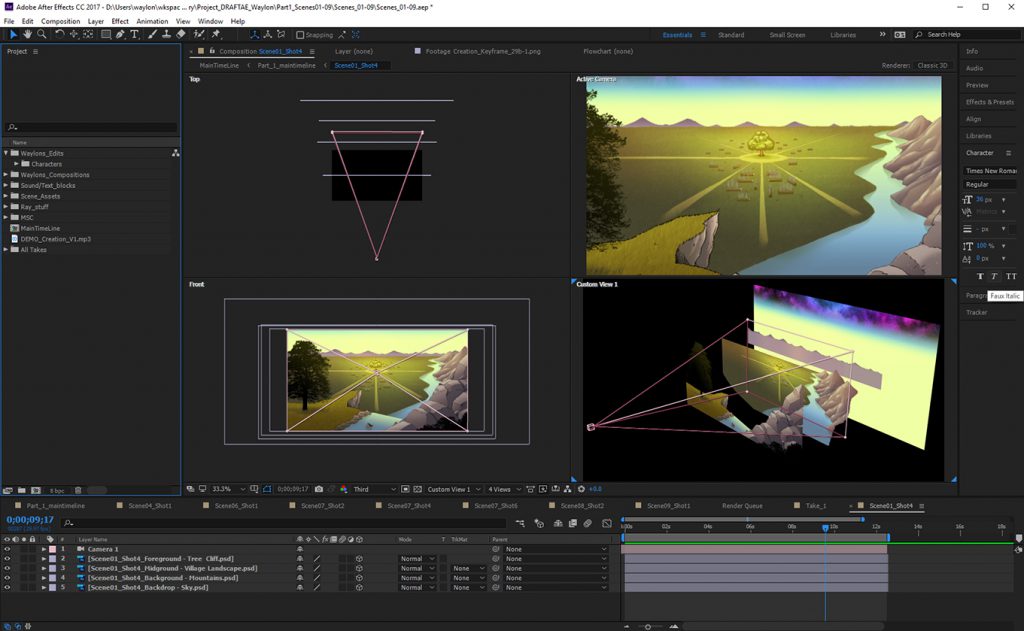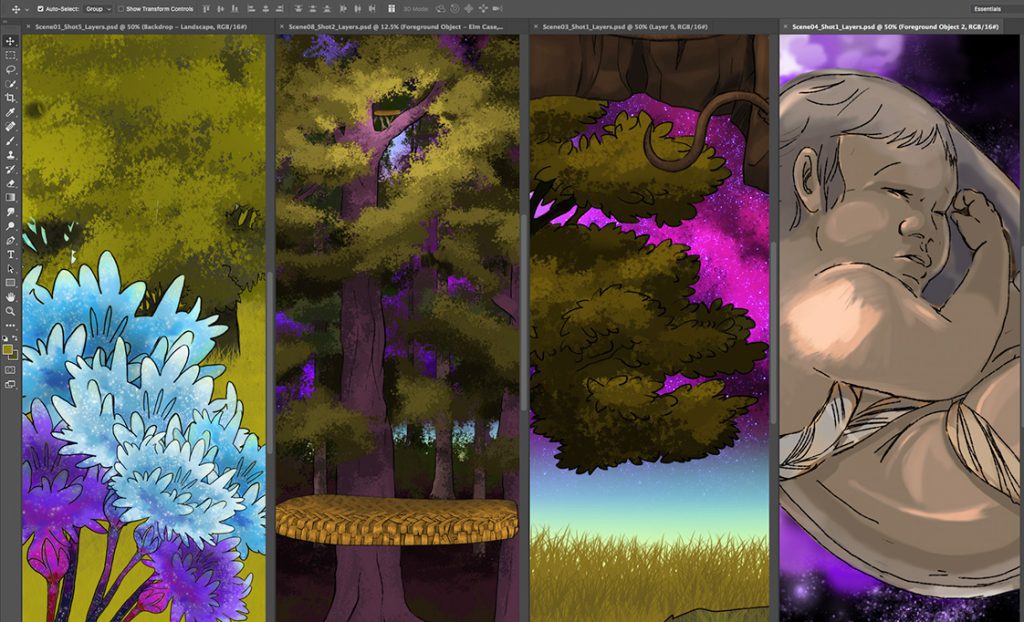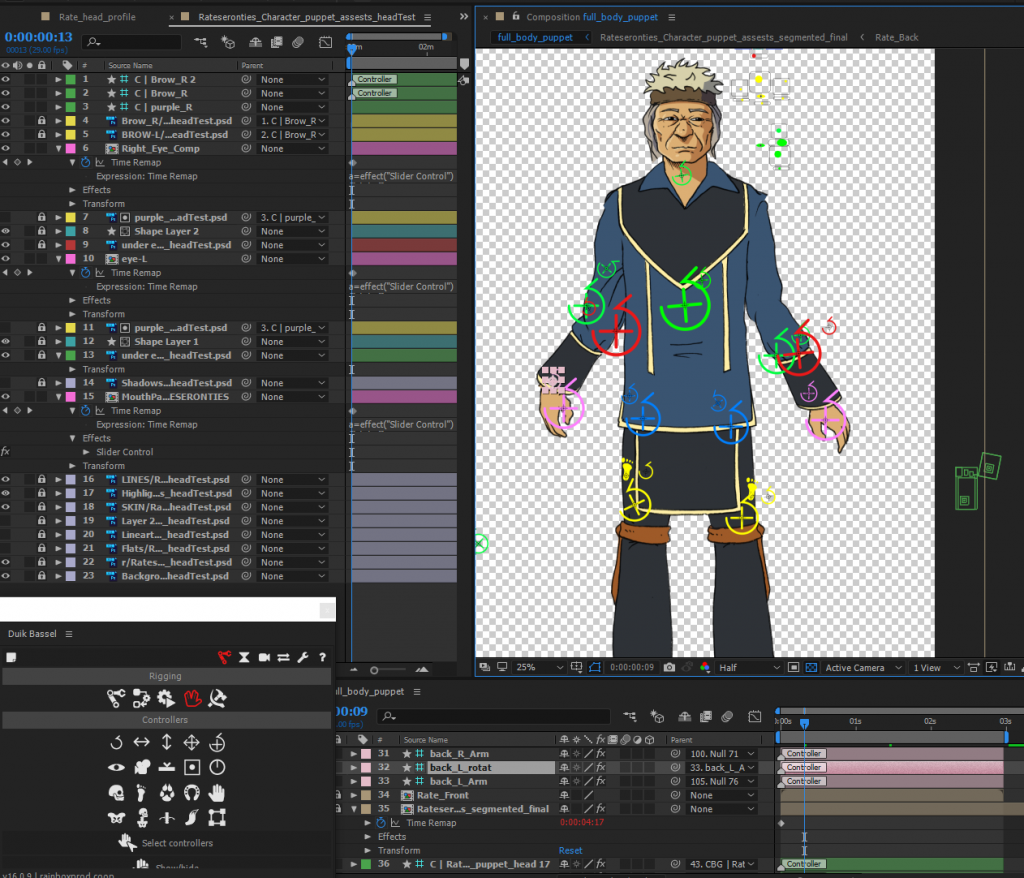Tsi Tiotonhontsatáhsawe: The Creation Story Project
by Dion Smith-Dokkie
March 28, 2019

My name is Dion Smith-Dokkie and I’m AbTeC/IIF’s social media coordinator!
For nearly a year, our team has been collaborating with the Kanien’kehá:ka Onkwawén:na Raotitióhkwa Language and Cultural Center (KORLCC). Together, KORLCC and AbTeC/IIF are creating an animated version of the Rotinonhsión:ni (Haudenosaunee/Iroquois) Creation Story in Kanien’kéha (the Mohawk way, i.e. language). The section we are currently working on is expected to be a fully-animated 30 minutes in length and will be the shortest of three sections—in other words, this project is huge!
After months of curious listening and brief updates, I had the chance to sit in on one of our monthly meetings—I was absolutely thrilled! First, some context.

The Initiative for Indigenous Futures has institutional and community-based partners throughout Canada, whom we collaborate with on many great projects. One of our local community partners is the Kanien’kehá:ka Onkwawén:na Raotitióhkwa Language and Cultural Center (KORLCC). Based in Kahnawà:ke Mohawk Territory, which is on the south side of the Kaniatarowanénhne (St. Lawrence River) across from Montreal, KORLCC works to preserve and promote the language and culture of the Mohawks of Kahnawà:ke. We were positively thrilled when KORLCC accepted our invitation to collaborate with them!
We joined the project at the end of the writing phase. KORLCC Curriculum Resource Director Trina Stacey oversees the creation of Kanien’kéha language learning materials, which range from books to audiovisual materials to real-world activities. This animated version of the Tsi Tiotonhontsatáhsawe (the Creation Story, “when the earth began”) in Kanien’kéha will be used as a multimedia language-learning tool!
Trina and KORLCC Graphic Artist and Cultural Liaison, Teiowí:sonte Thomas Deer have spent over a decade developing the script and art for this project. By the time we joined forces, Trina had meticulously combined and adapted a number of oral and written versions of the Tsi Tiotonhontsatáhsawe into a three-part script. Simultaneously, Teiowí:sonte worked with Trina to create concept art for the characters, settings, and scenes described in the script.

Enter AbTeC/IIF! We’re very proud of our team whose expertise, experimentation, and dedication are making for an electric and exciting process. In her role as IIF Partnership Coordinator and as an artist who has directed her own machinima, Skawennati connects us with KORLCC and, as the project develops, provides advice and feedback. Nancy Elizabeth Townsend is mentoring and assisting Waylon with project management, deadlines and workflow optimization.
Last summer, Research Assistant Kaia’tanó:ron Dumoulin Bush worked with AbTeC/IIF to create an initial version of the animatic—a motion storyboard—for the first installment of the Creation Story. She currently works with Teiowí:sonte to make edits, compile assets, fill in gaps in the original animatic, and prepares the environment of each scene.
Graduate Research Assistant Waylon Wilson is the lead project manager, handling the organizational aspects of the project; he also turns the motion storyboard into an animatic by layering each scene’s image-files, determines camera movements and angles—this way of working is known as 2.5D animation since a number of flat, unique images (assets) create a dynamic, deep space where components can move individually. At this point, the 2.5D animation is ready to get moving! Undergraduate Research Assistant Ray Tqogweg Caplin is the main animator. One of Ray’s most demanding tasks is the creation of character puppets. Ray takes the character artwork and segments the bodies based on where joints are and the range of movement required by each character.
While 2.5D animation is not new, we’re proud to have developed an innovative workflow adapted to the needs of this project. By using Duik 16 (Bassel), a free open-source After Effects plugin, After Effects’s capacity to support puppets has drastically improved. This reduces the number of platforms required to produce the animation and creates reusable, interchangeable character puppets. .
By making space in the workflow for character modification and the reuse of character puppets and animations, our process is streamlined! But let’s not forget about environments and camera movements. The many layers that form each scene are constructed to move in relation to the camera, which creates depth of field (perspective) in the animation. The joint AbTeC/IIF-KORLCC team reviews each final-draft scene together in which they approve the draft or return it for further adjustment.


My head was spinning at our most recent meeting. Above all, I was totally absorbed in seeing how the team works together. These meetings create an exciting space where we make the visual elements and Kanien’kéha storytelling resonate with one another.
Scenes must reflect the deeper symbolic meaning of the script. For instance, determining the layout of the village in Karonhià:ke (Sky World) aligns with the responsibility described in the name of Rarón:tote, the Guardian of the Standing Tree.
Our meetings are opportunities to identify inaccuracies. One assumption was that, like on Earth, the sky in Karonhià:ke would also appear blue. This is not true in the context of the Creation Story since the sky, as we know it, appears much later in the narrative. Together, we decided to use a half-twilight, half-galaxy sky to be more faithful to the story.
The team also worked through technical uncertainties. For example, how could we, with our restriction to 2.5D animation, establish 3-point geometric perspective inside of a longhouse? We wanted to avoid the need to re-draw the interior each time we moved the camera. Instead, Ray proposed that we create a 3D rectangular prism in which we could insert existing concept art of the longhouse interior (imagine wallpapering the inside of a virtual box). The scene’s layers, such as the puppets, could then be placed on top of this environment and the camera movements would then create the illusion of dynamic space!
Getting to see the thought process behind certain creative choices was fascinating. The collaboration ensures that deeper meanings and connotations are embedded in the visual elements. With this in mind, it was energizing to think about how the Creation Story shapes and is reflected in the lives of people today.

At one point, Trina Stacey explained the deeper meaning of a scene in the story. Rate’seróntie’s (The Uncle) has received a premonition of Iottsi’tsíson (Sky Woman) descending into our world. The premonition is jarring because it shows the Uncle a thought that has never existed before. The Uncle’s dream initiates a sequence of events that will create Turtle Island!
As someone looking in from the outside, I felt a beautiful resonance between this idea in the Creation Story—the idea of how momentous a new way of thinking can be—and the process and purpose of the Tsi Tiotonhontsatáhsawe project: to facilitate Kanien’kéha language learning so that students can see the world in a new way, through the lens of their language.
I would like to thank Skawennati, Nancy Elizabeth Townsend, Sara England, Trina Stacey, and Waylon Wilson for their help in preparing this introduction.